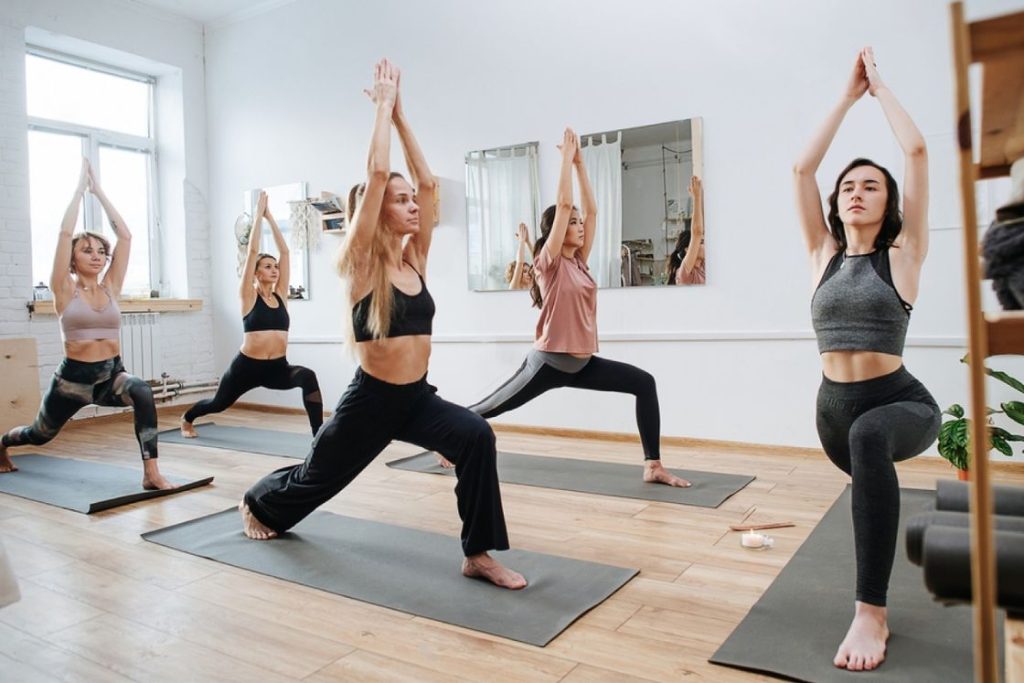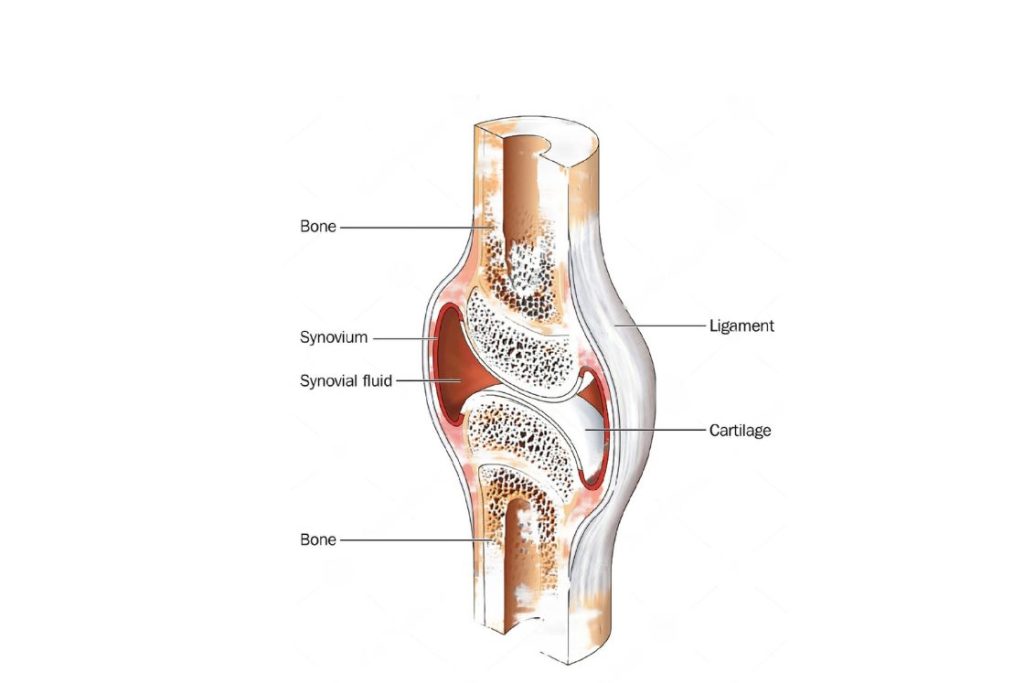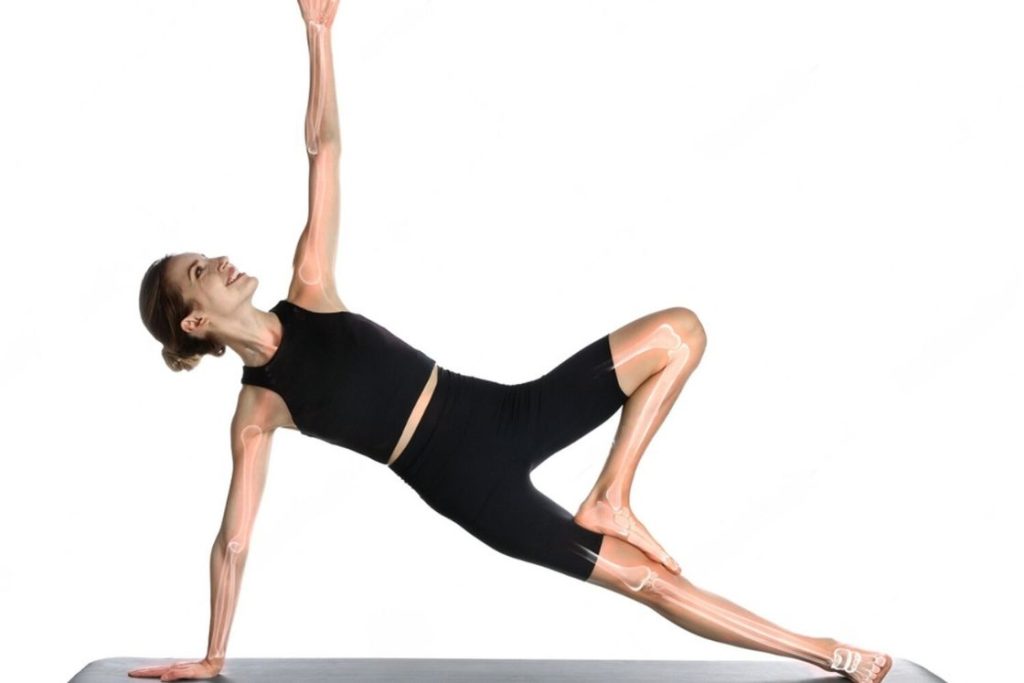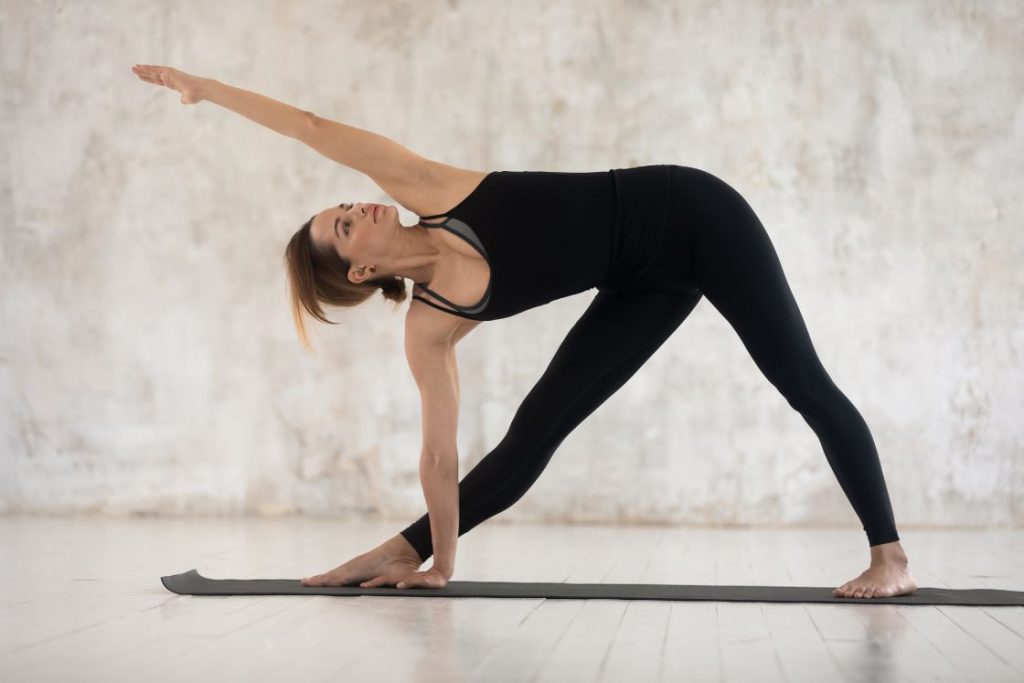
For a long time we have heard that yoga is good for bone health. Studies have even gone so far as to conclude that yoga can be very effective for conditions such as osteoarthritis, osteoporosis, arthritis and rheumatoid arthritis. But what is it exactly that attributes to yoga its restorative abilities in terms of joint health? Well, although there are several factors that contribute to the positive effects of yoga, one factor that really stands out is yoga’s proven effect on synovial fluid.
All of our major joints like knees, hips, shoulders, elbows, necks and so on are held together by cartilage, ligaments, muscles and tendons. But there is another important element that contributes to the health of your bone joints— Synovial Fluid.
All of our major joints have a cavity that is filled with a viscous fluid— called synovial fluid. This fluid is unique because it is a non-Newtonian fluid. Normal fluids, such as water and oil, maintain their viscosity even when they are squeezed, but not non-newtonian fluids can change their viscosity when pressure is applied around them.

As for the synovial fluid in our joints, when the opposing bones move and press against each other, when they are pressed together by the bones on either side, the viscosity of the synovial fluid increases and acts as a damping agent. Thus, the synovial fluid provides lubrication and cushioning for the bones of the joints during movement.
Unfortunately, this fluid may lose its thickness in joint-related medical conditions, or even from a sedentary lifestyle. Thankfully, this isn’t an entirely irreversible situation. Studies have shown that Yoga can actually increase (or help you retain) the viscosity of the Synovial fluid. How? Let’s explore that in the following sections.
How Does Yoga Thicken Synovial Fluid in Bone Joints?
Yoga, an ancient practice deeply rooted in promoting holistic well-being, works wonders not just for the mind and spirit, but also for the joints. Let’s dive straight into understanding how yoga has the potential to thicken the synovial fluid, that vital lubricant in our bone joints.
- Enhanced Circulation to joint capsules: One of the primary benefits of yoga is the boost it gives to overall circulation. As you stretch and move, blood flow increases. This ensures that the joint capsules receive more nutrients and oxygen. Better nourished joint tissues naturally produce healthier and more substantial synovial fluid.
- Stimulation of Synovial Membrane: Yoga often involves gentle compression and decompression of the joints. These movements stimulate the synovial membranes – the tissues responsible for synthesizing synovial fluid. When regularly stimulated, these membranes can become more active and produce thicker fluid.
- Improved Hydration for better fluid generation: Yoga encourages holistic well-being, which includes staying well-hydrated. Proper hydration ensures that the body has enough water to produce a good volume of synovial fluid. Moreover, certain yoga poses aid in better water distribution throughout the body, ensuring the joints are well-hydrated.
- Stress Reduction eliminates synovial inflammation: Chronic stress can lead to inflammation and may hamper the body’s ability to produce and maintain healthy synovial fluid. Yoga’s emphasis on mindfulness and relaxation reduces stress, indirectly promoting the health of the synovial fluid.
- Yoga boosts synthesis of synovial molecules: On a molecular level, the gentle motions involved in yoga might encourage the production of certain proteins and molecules that improve synovial fluid’s consistency. While research is still underway, early indications suggest that yoga can upregulate the synthesis of molecules like hyaluronic acid, a primary component that gives the synovial fluid its viscous consistency.
Yoga Helps You Maintain Overall Bone Health

As we discussed at the beginning of this article, joint fluid thickening is only one piece of the puzzle. Yoga offers benefits to the entire body, all of which contribute to the health of your bones in their own way. Let’s explore the direct benefits of yoga for joint health.
- Strengthens Surrounding Muscles: Yoga poses often involve holding postures that require muscle engagement. As these muscles become stronger, they offer better support to the joints, ensuring they’re stable and less prone to injuries.
- Increases Flexibility: The stretching involved in yoga helps in lengthening and relaxing the muscles around the joints. This increased flexibility allows for a greater range of motion, reducing the risk of joint wear and tear over time.
- Boosts Circulation: Yoga poses, especially those that promote twists and inversions, ensure better blood flow to the joints. Enhanced circulation means more nutrients and oxygen reach the joint tissues, promoting their overall health and vitality.
- Promotes Joint Mobility: Regular yoga practice encourages movement in the joints, which can prevent stiffness. This movement ensures that synovial fluid is evenly distributed, nourishing cartilage and reducing friction within the joint.
- Reduces Joint Pain: By strengthening muscles, increasing flexibility, and promoting better circulation, yoga can alleviate joint pain. Many practitioners have reported reduced pain in conditions like arthritis after incorporating yoga into their routines.
- Encourages Proper Alignment: Proper posture is a core element of yoga. By teaching the body correct alignment, yoga ensures even distribution of weight and reduces undue stress on certain joints, especially in the spine and lower extremities.
- Aids in Weight Management: While yoga might not be the most intense calorie-burning exercise, it plays a role in weight management. Less weight means reduced pressure on weight-bearing joints, such as the knees and hips, leading to increased longevity of these joints.
- Reduces Inflammation: One of the profound benefits of yoga is its ability to reduce systemic inflammation. Chronic inflammation can lead to joint pain and degradation. By promoting relaxation and stress reduction, yoga helps in lowering the levels of pro-inflammatory molecules in the body. Reduced inflammation not only alleviates pain but also plays a role in protecting the joints from inflammatory diseases like rheumatoid arthritis. Engaging in regular yoga sessions can act as a natural anti-inflammatory, safeguarding the health and longevity of your joints.
Yoga Poses that Have Benefits on Bone Health

The magic of yoga extends far beyond mental well-being. Some poses, in particular, stand out for their ability to bolster bone health. Let’s delve into these yoga postures that offer tangible benefits for your bones.
- Tree Pose (Vrksasana): A balance pose, the Tree Pose strengthens the bones of the legs, especially the tibia and fibula, while also enhancing ankle stability.
- Triangle Pose (Trikonasana): This posture engages the legs and arms, promoting bone health in the femur, humerus, and the pelvic region. It also aids in spine flexibility.
- Bridge Pose (Setu Bandha Sarvangasana): Excellent for the spine, this backbend also stimulates the thyroid, potentially aiding those with osteoporosis.
- Downward Facing Dog (Adho Mukha Svanasana): A fundamental pose, it strengthens the bones of the arms and legs while also providing a gentle inversion for improved circulation to the upper body.
- Warrior II (Virabhadrasana II): This pose promotes hip stability and strengthens the femur, pelvis, and spine. The arm extension further benefits the arm bones.
- Plank Pose: A powerhouse for bone strengthening, the Plank pose works on the wrists, arms, shoulders, and even the vertebral column, making it an all-rounder for bone health.
- Chair Pose (Utkatasana): Primarily targeting the spine, pelvis, and femur, this pose also builds stamina and strength in the legs.
- Extended Triangle Pose (Utthita Trikonasana): This pose helps improve the strength and flexibility of the spine, legs, and arms, enhancing bone resilience.
- Locust Pose (Salabhasana): A beneficial back strengthening pose, Locust Pose focuses on the vertebrae, promoting a healthy spine.
- Bound Angle Pose (Baddha Konasana): Beneficial for hip joints, this seated pose also aids in improving the flexibility and health of the pelvic bones.
Yoga Helps you Avoid Joint Injuries by Improving Body Awareness
To conclude our discussion of the effects of yoga on synovial fluid and bone health, one benefit stands out: improved body awareness. Through its methodical and mindful movements, yoga not only strengthens bones and improves synovial fluid, but also heightens our sense of body position, movement, and alignment.
Each yoga pose requires focused attention. This increased mindfulness makes us more receptive to our body’s signals. Whether it’s a slight strain in the knee or an overstretched wrist, when we’re in tune with our body, we can recognize and correct incorrect postures or movements that could lead to injury.
In addition, when practiced consistently, yoga promotes a strong sense of balance and coordination. This naturally reduces the risk of falls or sudden joint overloads, which are often responsible for joint injuries.
In essence, yoga serves as a double shield for our joints. While internally fortifying them through the enhancement of synovial fluid, it also externally protects them by refining our movement and understanding of our own body. For anyone keen on joint health, it’s evident that the yoga mat is not just a space for relaxation, but a sanctuary for joint preservation.
Frequently Asked Questions on Yoga for Joint Health
Can Yoga help manage Arthritis?
Yes, yoga can be beneficial in managing arthritis. It offers gentle stretching, which can improve joint mobility, reduce stiffness, and promote strength in the muscles surrounding the affected joints. However, it’s essential to consult with a healthcare professional before starting yoga, especially if you have severe arthritis.
Can Yoga help manage Osteoarthritis?
Certainly. Yoga can be especially helpful for osteoarthritis by promoting flexibility and strength. Regular practice can improve joint function, reduce pain, and potentially slow down the progression of the disease. Focus on poses that target affected joints, but always ensure they are comfortable and pain-free.
Can Yoga help manage Rheumatoid Arthritis?
Yes, yoga can be a supportive tool in managing rheumatoid arthritis. It aids in stress reduction, which is essential given that stress can exacerbate RA symptoms. Additionally, the gentle movements in yoga can help improve joint mobility and decrease pain. However, during flare-ups, it’s crucial to be gentle and possibly avoid certain poses.
Can Yoga help manage Osteoporosis?
Yoga can be beneficial for those with osteoporosis by increasing bone density, balance, and muscle strength. However, individuals with osteoporosis should avoid high-impact poses and any posture that puts too much strain on the bones. Consulting with an instructor familiar with osteoporosis is recommended.
What is the best Yoga for Arthritis?
Gentle, restorative, and Iyengar yoga can be beneficial for those with arthritis. These styles emphasize alignment, slow movements, and use props to ensure poses are accessible. Poses like the Tree Pose, Bridge Pose, and Cat-Cow are particularly beneficial. Always listen to your body and avoid any pose that causes pain.
What is the best Yoga for Joint Pain?
For joint pain, restorative yoga or Yin yoga can be especially beneficial. These styles focus on passive stretching and holding poses for longer periods, which can release tension and improve joint mobility. Poses like the Child’s Pose, Pigeon Pose, and Supine Hand-to-Big-Toe Pose can be effective.
Can yoga relieve joint inflammation?
Yoga, by promoting relaxation and stress reduction, can help reduce systemic inflammation. Additionally, regular practice increases circulation, ensuring a better flow of anti-inflammatory agents to affected areas. While it’s not a replacement for medical treatments, yoga can complement other anti-inflammatory interventions.
What is the best yoga for back pain?
For back pain, it’s essential to focus on poses that strengthen the back and core while improving flexibility. Gentle yoga styles are preferable. Poses like the Downward Facing Dog, Child’s Pose, Sphinx Pose, and Cat-Cow stretches can offer relief. As with all conditions, it’s crucial to consult with a healthcare professional and possibly seek out a yoga instructor experienced in managing back pain.




